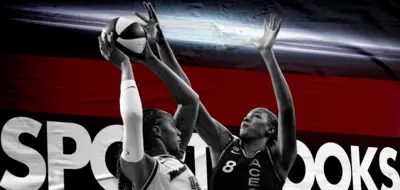
Even if you’re not a regular sports bettor, you’ve probably heard of moneyline odds. Alongside the point spread and the over/under, the moneyline is one of the most common wager types in sports betting. In this article, we’ll break down exactly what a moneyline bet is and how it works.
You might be wondering: What does the moneyline actually mean? What are you betting on? How do you read these odds? And are there any smart strategies to consider? If you’re looking for a complete overview of sports betting, check out our comprehensive betting guide. But here, we’re focusing entirely on the moneyline.
-
 100% up to $400 + 50 Free SpinsPlay Now
100% up to $400 + 50 Free SpinsPlay NowT&C apply, 18+, Play responsibly
-
 50% bonus up to $250Play Now
50% bonus up to $250Play NowT&C apply, 18+, Play responsibly
-
 50% up to $200Play Now
50% up to $200Play NowT&C apply, 18+, Play responsibly
-
EXCLUSIVE BONUS
 125% up to $2,500Play Now
125% up to $2,500Play NowT&C apply, 18+, Play responsibly
-
 $500 Sign Up BonusPlay Now
$500 Sign Up BonusPlay NowT&C apply, 18+, Play responsibly
How Moneyline Bets Work
The term moneyline bet can be a little confusing at first. Unlike the “point spread,” which at least hints at what you’re betting on, the moneyline doesn’t give much away.
That said, the concept is as simple as it gets. A moneyline bet is just picking the winner—nothing more. While point spreads and over/unders deal with margins and totals, the moneyline is binary: choose your winner, and that’s the bet.
Where things get trickier is in reading moneyline odds. The way they’re presented isn’t always intuitive, and that’s where beginners can stumble.
If you’re looking at the latest NFL betting odds, you might see a game listed like this: Buffalo Bills (–120) vs. Kansas City Chiefs (+110). While you can always use a betting calculator to work out the exact payouts, you usually don’t need one to understand the basics.
Negative moneylines—such as the Bills at –120—indicate the favorite. The number tells you how much you need to risk to win $100. For example, at –200, you would need to wager $200 to make a $100 profit (a $300 total return including your stake).
Positive moneylines—like the Chiefs at +110—indicate the underdog. These odds tell you how much profit you stand to make on a $100 bet. In this case, a $100 wager on Kansas City would return $110 in profit, plus your original $100 stake for a total of $210.
Pretty easy, right? It can get a little more complicated when you're dealing with weird moneylines, such as -165 or +115, but that's where betting calculators come into play.
Finding moneyline action is just as easy. Every online sportsbook offers these wagers. They are the most common lines in the industry. But where you bet matters, so we've put together a list of our favorite sites for those looking to place moneyline wagers:
-
 100% up to $400 + 50 Free SpinsPlay Now
100% up to $400 + 50 Free SpinsPlay NowT&C apply, 18+, Play responsibly
-
 50% bonus up to $250Play Now
50% bonus up to $250Play NowT&C apply, 18+, Play responsibly
-
 50% up to $200Play Now
50% up to $200Play NowT&C apply, 18+, Play responsibly
-
EXCLUSIVE BONUS
 125% up to $2,500Play Now
125% up to $2,500Play NowT&C apply, 18+, Play responsibly
-
 $500 Sign Up BonusPlay Now
$500 Sign Up BonusPlay NowT&C apply, 18+, Play responsibly
Moneyline vs. Point Spread Odds
We cover this comparison more in-depth within our moneyline vs. point spread guide, but the following hypothetical gives you the overall lowdown.
Let’s say you’re a Miami Heat fan, confident they’ll beat the New York Knicks in an upcoming playoff game. The catch? The Heat are nine-point favorites, meaning they’d have to win by more than nine for a spread bet to cash. While you trust Miami to win, you can easily imagine the Knicks keeping it close—NBA underdogs are famous for sneaking in a late cover when the favorite eases up in the fourth quarter.
In this case, the safer play isn’t the spread, but the moneyline. With a moneyline bet, the margin doesn’t matter—you just need Miami to win outright. The tradeoff is cost. The bigger the favorite, the steeper the price. For example, if the Heat are listed at –285, you’d need to risk $285 just to win $100.

Just so we're clear: You do not have to wager in increments of $100 to bet on the moneyline. This amount is used to help make it easier to understand the odds at a glance. Using the above scenario, if you wanted to make a $10 profit betting on the Heat, you would have to wager $28.50 to do so. If you bet $10 at -285 and your bet won, you would make a $3.51 profit and receive your original stake back.
This also gets at another benefit of the moneyline compared to point spreads: a range of potential payouts.
When you’re betting on a point spread, the odds are often set around –110, though some sportsbooks may offer –105, –115, or other variations depending on the matchup and market. Moneylines, on the other hand, give you more flexibility. You can back the heavy favorite, which offers smaller payouts, or take the underdog, which typically returns a larger profit relative to your stake.
Yes, by betting the moneyline, you'd be guaranteeing a victory from an underdog, lest your wager fail. Still, it's nice to have the option.
Moneyline Futures Betting
Moneyline odds are used heavily in futures betting, which makes sense. You're attempting to pick a winner of a distant event—be it a league division, conference, or outright championship—and moneyline odds are the format used for selecting outright victors.
Even bettors who typically prefer point spreads often find themselves drawn to futures, largely because the payouts can be much more lucrative. That makes sense: most futures bets are placed before a season begins, when the outcome is highly uncertain. Factors like injuries, roster changes, or shifts in competition can dramatically alter the landscape.
In exchange for that uncertainty—and the patience required—sportsbooks offer bigger potential rewards. For instance, ahead of the 2025 Super Bowl, outright favorites like the San Francisco 49ers and Kansas City Chiefs were priced around +600 to +700, meaning a $100 wager would return $600 to $700 in profit if they came out on top.
Moneyline Betting Strategies
Just like every other odds type, the moneyline is home to a bunch of different approaches. Please note that none of these betting strategies are foolproof. They are imperfect and, in some cases, incredibly misguided.
With all of that in mind, we break down the two approaches that intrigue us most.
Parlaying Moneyline Favorites
Moneyline betting can be unattractive if you’re backing a heavy favorite. For example, taking a team at –350 means you’d need to risk $350 just to make a $100 profit. That kind of return doesn’t appeal to many bettors.
Parlaying these types of moneylines together is a way around that. The potential payouts still won't be as mammoth as they would be point-spread or underdog parlays, but things get really interesting if you can spot a handful of monster favorites.
Take the following hypothetical bet slip:
- Kansas City Chiefs (–400)
- San Francisco 49ers (–350)
- Baltimore Ravens (–300)
- Philadelphia Eagles (–280)
- Dallas Cowboys (–250)
Investing in these lines separately isn’t too appealing if you don’t have a large bankroll. However, if you parlay them, the odds multiply together to create a much larger potential payout than betting each game individually. The trade-off is higher risk—every team in the parlay must win for the ticket to cash.
Indeed, the sheer number of winners you're trying to pick makes it risky. But because they're heavy favorites, the potential to miss isn't astronomically high, otherwise, the prospective payout would be much larger. This is a great strategy for someone looking to drive up the stakes without subjecting themselves oversized investments or ridiculously unlikely scenarios.

Small Investments in Mega Moneyline Underdogs
Look, let's be real with one another. Taking the New York Giants to beat the Dallas Cowboys at +600 isn't necessarily the wisest decision. It's one thing if you believe the Giants are being absurdly underestimated, but failing that, the idea behind throwing money on them doesn't much track.
Then again, some people believe it does when pairing one huge underdog with a couple of others.
To be sure, we’re not talking about another parlay. Rather, working heavy moneyline underdogs means picking out three to five long-shot bets and spreading smaller wagers across them. The odds of a +350 underdog hitting are fairly slim, but if you also back others at prices like +275, +400, +325, and +375, you might be onto something. The goal is for one or two of those bets to cash, which can cover the losses from the others and still leave you ahead.
The downside to this method is that it requires a decent bankroll. Spreading $100 across five separate underdogs won’t move the needle much. But if you’re already planning to stake a few hundred dollars in a given NFL weekend, dividing it across multiple long shots could make sense.






